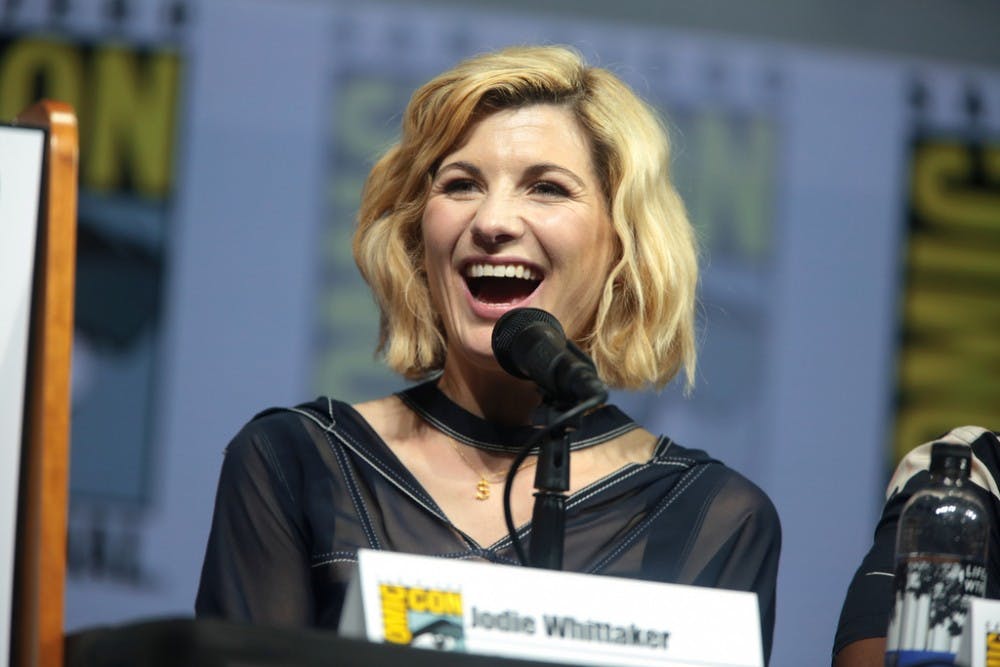For the first time in its 55 year history, Doctor Who’s latest season, which premiered on Sunday, features a woman as the titular character. Spoiler alert: Jodie Whittaker (Broadchurch, Black Mirror) nails the role. She is brilliant, funny and warm. She is the Doctor.
When the BBC announced that Whittaker would be taking over the role from Peter Capaldi back in July 2017, Doctor Who fans were split. Many, like myself, were elated to see a female actor starring in one of the most prominent television programs in sci-fi history. Others, however, criticized the BBC for casting Whittaker into a role previously only occupied by white men.
I loved Doctor Who from the first episode I watched during my sophomore year of high school. I grew attached to each actor who played the Doctor and respected that the character was vulnerable, compassionate, witty and intellectual. The Doctor, an ancient time-traveling alien, has the ability to regenerate into a new body upon death, which not only ensures that the show can go on but creates opportunities for new actors to play with variations on the role.
The season premiere, “The Woman Who Fell to Earth,” is pretty standard by regeneration episode standards. Like her predecessors before her, the Doctor is stuck on Earth trying to fight an alien without her sonic screwdriver or TARDIS. We get to watch Whittaker stumble across and confuse a group of humans, outwit a villain, and finally, after an hour of adjusting to a new body and undergoing an identity crisis, declare herself the Doctor. It’s a joy to watch this process unfold.
Sunday’s episode doesn’t necessarily introduce anything new to viewers, but it is executed well and is clearly designed to welcome new fans into the show. And there is a lot to like! The monster, Tim Shaw, is truly frightening; its face is embedded with the teeth of those it has killed. The special effects and cinematography are striking and memorable. The dialogue is snappy and energetic.
Chris Chibnall, the new showrunner, focuses heavily on the humans with whom the Doctor meets, and later befriends: the companions. This season, we get three instead of the traditional one!
We first meet Ryan Sinclair (Tosin Cole), a teenager with dyspraxia, a disorder affecting motor functions. He lives with his grandmother, Grace, and her second husband – another of the Doctor’s companions – Graham (Bradley Walsh). Lastly, there is the young police officer Yasmin Khan (Mandip Gill), who is stifled in her current occupation and craves adventure.
It takes a couple minutes into the episode for us to meet the new Doctor, but when she bursts onto screen, the episode truly takes off.
I didn’t expect to become emotional, but watching Whittaker do all the typical “Doctor” things – command the room, take charge of situations, ask question after question — made me quite teary. Women are so often silenced and relegated to assistant roles, both in television and in real life. Seeing Whittaker beamingly assert herself is refreshing and revolutionary. I felt empowered and proud of the show for taking the plunge that so many of us had wanted for so long.
Whittaker’s casting is one of many changes the show is undertaking. This season, Doctor Who will feature its first writers of color (shockingly long overdue). In addition, its editors are majority female and its directors will be 50 percent male and 50 percent female. For a show that is often reflective of its time (or ahead of it), committing to diversity and inclusion, both on and off camera, seems fitting.
These decisions harken back to the show’s inception in 1963. The original series featured the BBC’s first female drama producer, Verity Lambert, and first director of South Asian descent, Waris Hussein. The show, which was made as a family program, tackled difficult themes like loss and fear. It also addressed war and the rise of Nazi Germany through allegory and metaphor.
Over the years, Doctor Who has continued to educate its viewers on political topics. In “The Lie of the Land,” the Doctor fights an alien race called the Monks which feeds humans fake news and a distorted record of history. “The Zygon Inversion” criticizes the cyclical nature of war and the growing xenophobia in today’s world. The way that Doctor Who comments on current events is thinly veiled, but perhaps that is its intention.
Doctor Who is simultaneously an historic, current and futuristic show, and its core philosophies never change — that is what draws me back time and time again. Its hero, the Doctor, approaches new planets and new races with curiosity, not fear.
The Doctor seeks first to understand antagonists, rather than destroy, and relies on words and wit, not weapons. And the Doctor’s relationship with their companions is built on a strong current of empathy and emotional vulnerability. Even though its protagonist is an alien, the show is deeply concerned with what it is to be human.
I’m thrilled that fans, especially children, can find a modern yet timeless hero in the Doctor, and it reassures me that the program will continue to impart important lessons through creative and innovative stories. For 55 years, audiences have looked at the Doctor as a role model. Now for the first time, fans can see that women can be role models, too.





